The global plastic jar packaging market is expected to grow from USD 19.34 billion in 2025 to USD 30.34 billion by 2035, reflecting a compound annual growth rate (CAGR) of 4.4% over the forecast period. This growth is driven by several factors, including increasing demand for cost-effective, lightweight, and durable packaging solutions across various industries such as food and beverages, personal care, pharmaceuticals, and household products.
Plastic jars are popular for their versatility, ability to preserve product integrity, and ease of use. These advantages make plastic jars ideal for packaging a wide variety of products, from edible items like jams, sauces, and honey, to non-edible products such as cosmetics, cleaning agents, and pharmaceuticals. Additionally, plastic jars are also highly customizable, which allows brands to create packaging that is visually appealing and easily accessible to consumers.
With the increasing focus on sustainability, many packaging manufacturers are moving toward eco-friendly designs and materials. The growing demand for recyclable, reusable, and biodegradable plastic packaging is shaping the market. Innovations in plastic recycling technologies and the use of bio-based plastics are helping to address concerns about the environmental impact of traditional plastic packaging.
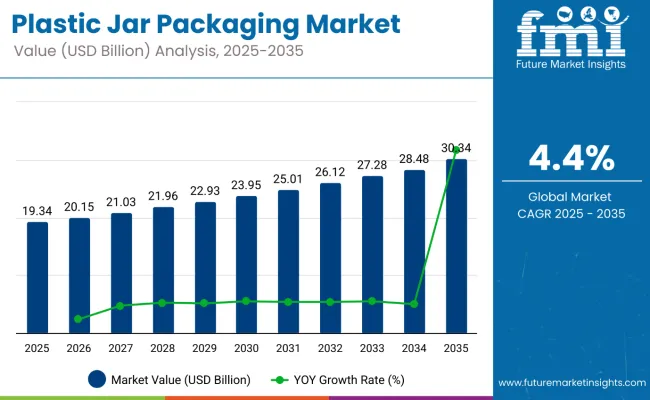
The growing preference for convenient, tamper-proof, and lightweight packaging is further propelling the demand for plastic jars, particularly in food packaging. Additionally, the rise in e-commerce has contributed to the increasing demand for durable, secure packaging that ensures the safe transportation of goods.
In a 2023 interview with Packaging Dive, Kevin Kwilinski, CEO of Berry Global, emphasized, “As consumer preferences shift toward sustainability, we are committed to innovating our packaging solutions to meet these demands. Our focus is on developing plastic jar packaging that is not only functional but also environmentally responsible.” This statement highlights the growing industry commitment to innovation and sustainability.
With technological innovations and sustainability efforts driving market growth, the plastic jar packaging market is set for continued expansion through 2035, offering new opportunities for both packaging manufacturers and consumers.
Government regulations in the plastic jar packaging market are critical to ensuring product safety, environmental responsibility, and compliance with international trade standards. These regulations span various domains including food safety, chemical usage, manufacturing practices, and recycling mandates. As plastic jars are widely used in food, pharmaceutical, and personal care industries, authorities like the U.S. FDA, the European Commission, and other global regulatory bodies have established strict guidelines to control material quality, labeling, and production hygiene.
The global trade of plastic jars is influenced by demand across food, pharmaceutical, personal care, and chemical sectors. With increasing emphasis on lightweight, cost-effective, and recyclable packaging, cross-border movement of plastic jars and related packaging solutions continues to grow.
The below table presents the expected CAGR for the global plastic jar packaging market over several semi-annual periods spanning from 2025 to 2035.
| Particular | Value CAGR |
|---|---|
| H1 | 4.2% (2024 to 2034) |
| H2 | 4.6% (2024 to 2034) |
| H1 | 4.1% (2025 to 2035) |
| H2 | 4.7% (2025 to 2035) |
In the first half (H1) of the decade from 2024 to 2034, the business is predicted to surge at a CAGR of 4.2%, followed by a slightly higher growth rate of 4.6% in the second half (H2) of the same decade.
Moving into the subsequent period, from H1 2025 to H2 2035, the CAGR is projected to decrease slightly to 4.1% in the first half and remain relatively moderate at 4.7% in the second half. In the first half (H1) the market witnessed a decrease of 10 BPS while in the second half (H2), the market witnessed an increase of 10 BPS.
The 10-30 Oz capacity segment holds a dominant 40% share in 2025, driven by consumer demand for mid-sized packaging. Polyethylene (PE) materials lead the market with a 35% share, further divided into HDPE and LDPE, due to their durability and cost-effectiveness.
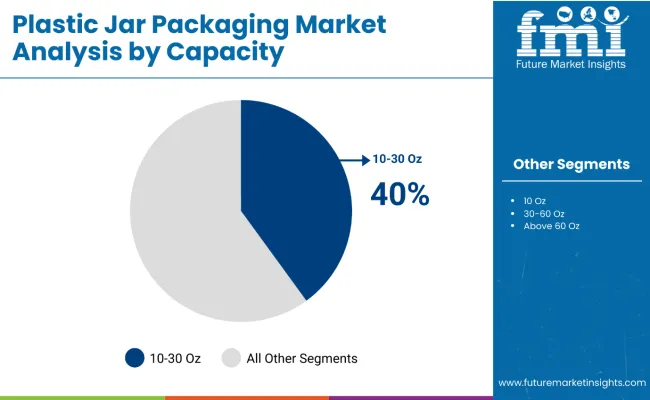
The 10-30 Oz capacity segment is expected to dominate the plastic jar packaging market in 2025, capturing 40% of the market share. This mid-range capacity is particularly favored for a variety of consumer products, including food items, personal care products, and household goods. The size is optimal for products such as sauces, jams, cosmetics, and cleaning agents, offering the right balance between convenience and value.
Plastic jars in the 10-30 Oz range are lightweight, durable, and cost-effective, making them ideal for both retail and e-commerce packaging. Their wide usage across multiple sectors, from food and beverages to cosmetics and household products, further strengthens their market position. The 10-30 Oz jars also allow for better shelf management and packaging versatility, enhancing product visibility and appeal.
As consumer preferences shift toward functional, convenient packaging, the 10-30 Oz segment is poised for sustained growth. Manufacturers are continuously innovating to improve the design, safety features, and sustainability of jars in this capacity range to meet evolving market demands.
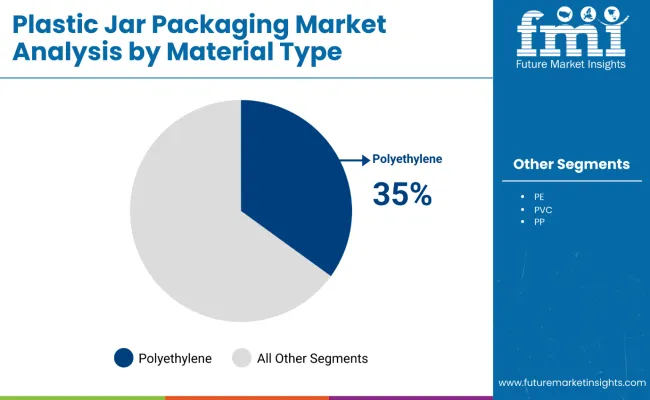
Polyethylene (PE) materials are projected to lead the plastic jar packaging market with a 35% share in 2025, with PE being subdivided into HDPE (High-Density Polyethylene) and LDPE (Low-Density Polyethylene). PE is the material of choice in the industry due to its excellent durability, cost-effectiveness, and versatility. It provides superior resistance to impact, moisture, and chemicals, making it ideal for a wide range of products, including food and beverages, personal care items, and cleaning products.
HDPE is widely used in the production of rigid plastic jars, especially for products that require a strong, durable container. Its ability to withstand rough handling and harsh environmental conditions enhances its suitability for both retail and industrial applications. On the other hand, LDPE, with its lower-density structure, is typically used for flexible applications and is favored in situations where ease of handling and recyclability are priorities.
The increasing consumer demand for sustainable packaging solutions has driven innovations in PE materials, including the development of recyclable PE options, aligning with growing environmental concerns. This sustainability push ensures that PE materials remain dominant in the plastic jar packaging market through 2035.
Health and food safety rules and regulations play an important role in defining the plastic jars market since they establish critical standards for both safety and food packaging. This law ensures that materials used for packaging, such as plastic jars, are nontoxic, thus they do not leak harmful contents into the stored food.
The International Organization for Standardization outlines these criteria with ISO 22000, a normative reference to the requirements of a food safety management system, which may be certified to it. This specifies what an organization needs to do in order to demonstrate its ability to provide adequate control of hazards in food safety and safety itself, along with the safety of food in its intended consumption.
Such packaging solutions support compliance with such standards that help in protecting the health of consumers, hence why manufacturers prefer to utilize compliant packaging solutions like plastic jars.
Plastic jars are on the increase as more and more food manufacturers seek compliance with health and safety regulations. Plastic jars can be manufactured using different types of material and dimensions based on the demand of particular regulations to be fulfilled.
This flexibility and adaptability have enabled manufacturers to produce plastic jars that are not only safe but functional, like an airtight seal and moisture resistance. With strict safety regulations and the plastic jar's ability to fulfill the needs, they drive the demand for these jars across various regions.
A majority of businesses have switched to virtual sales models, especially on the B2B side. There has been considerable demand for high-quality, secure, and reliable packaging solutions, such as plastic jars.
More than 90% of B2B businesses have transitioned to a virtual sales model over the past 2-3 years, as per the International Trade Administration, the expansion of e-commerce translates into huge demands from packaging products that are capable to withstand long-distance journeys while safely encasing product content. Plastic jars are preferred as a packaging choice for their strength, affordability, and flexibility.
This e-commerce-driven demand has afforded plastic jars for use in packaged products, including food items, cosmetics, and household care. The plastic jar is lightweight, reducing transportation costs to some extent while ensuring that the product is delivered to the customers in the required condition and quality.
Furthermore, plastic jars have tamper evidence and moisture resistance capabilities; this offers a better protective atmosphere for products being transported. Due to the rapid expansion of virtual sales platforms by businesses, the demand for new and safe packaging solutions like plastic jars is likely to increase in the future, thereby increasing their demand across the globe.
The major restraint for the plastic jars market is growth in preference for sustainable packaging since consumers are opting for environmentally friendly alternatives. Enhancing awareness about the environment has created an urge among consumers for packaging materials made of glass, metal, or biodegradable materials.
This change in consumer preference might have a negative impact on the market share of traditional plastic jars. Also, the trend of biodegradable and compostable packaging solutions prominently from the food and personal care industries may pose challenges where sustainability impacts the purchasing decision of the consumers.
As businesses are focusing on satisfying the demand of consumers for responsible packaging may decline the demand and hamper the plastic jars market in upcoming years.
Tier 1 companies comprise market leaders with a market revenue of above USD 100 million capturing significant market share of 5% to 15% in global market. These market leaders are characterized by high production capacity and a wide product portfolio. These market leaders are distinguished by their extensive expertise in manufacturing across multiple packaging formats and a broad geographical reach, underpinned by a robust consumer base.
They provide a wide range of series including recycling and manufacturing utilizing the latest technology and meeting the regulatory standards providing the highest quality. Prominent companies within tier 1 include Alpla Packaging Inc., Amcor Plc, Berry Global Inc., Pretium Packaging, LLC and Silgan Holdings Inc.
Tier 2 companies include mid-size players with revenue of USD 20 to 100 million having presence in specific regions and highly influencing the local market. These are characterized by a strong presence overseas and strong market knowledge. These market players have good technology and ensure regulatory compliance but may not have advanced technology and wide global reach.
Prominent companies in tier 2 include Graham Packaging Company Inc., Synergy Packaging (PACT GROUP), Comar, LLC, TricorBraun, Robinson plc, Takemoto Yohki Co., Ltd., PetcoGulf, H&K Müller GmbH & Co. KG, Altium Packaging LLC., Avantor Inc.
Tier 3 includes the majority of small-scale companies operating at the local presence and serving niche markets having revenue below USD 20 million. These companies are notably oriented towards fulfilling local market demands and are consequently classified within the tier 3 share segment.
They are small-scale players and have limited geographical reach. Tier 3, within this context, is recognized as an unorganized market, denoting a sector characterized by a lack of extensive structure and formalization when compared to organized competitors.
The section below covers the future forecast for the plastic jar packaging market in terms of countries. Information on key countries in several parts of the globe, including North America, Latin America, East Asia, South Asia and Pacific, Western Europe, Eastern Europe and MEA is provided. Canada is anticipated to remain at the forefront in North America, with a CAGR of 3.7% through 2035. In East Asia, China is projected to witness a CAGR of 5.1% by 2035.
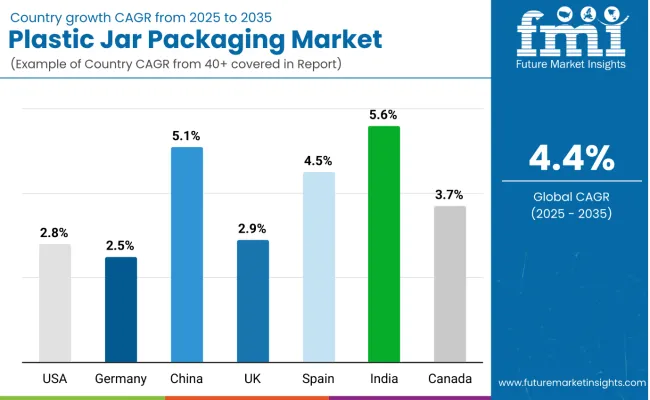
| Countries | Value CAGR (2025 to 2035) |
|---|---|
| USA | 2.8% |
| Germany | 2.5% |
| China | 5.1% |
| UK | 2.9% |
| Spain | 4.5% |
| India | 5.6% |
| Canada | 3.7% |
The UK has poised for plastic jar packaging expansion at a 2.9% CAGR until 2035, outshining several other European countries. The UK is also known for a strong research base and its pharma production of high-grade medicines and vaccines. Based on reports by The Association of the British Pharmaceutical Industry, exports of medicinal and pharmaceutical products from the UK stood at £26.1 billion in 2024.
This growth translates for reliable packaging solutions that guarantee safe delivery of products without any damage and desired quality. Plastic jars, with improved barrier properties against moisture, oxygen, and UV light, make them crucial for maintaining the quality of stability of sensitive pharmaceutical products.
UK pharmaceutical exports are increasing day by day, and, with it, the demand for plastic jar packaging to ensure safety and security for these products in transit and storage.
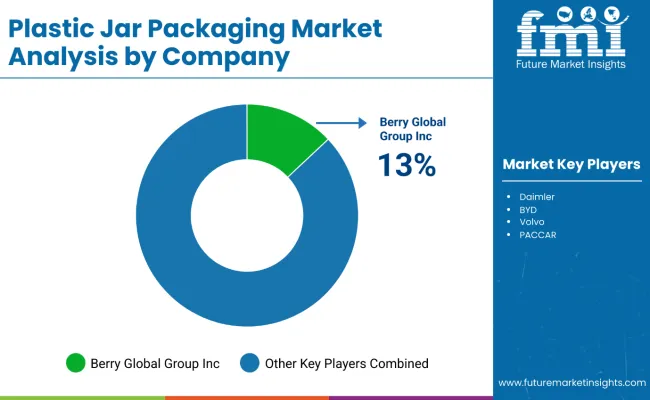
The plastic jar packaging market is highly competitive, driven by demand in food, cosmetics, and pharmaceuticals. Key players include Berry Global, Amcor, RPC Group, and Silgan Holdings. These companies compete on innovation, sustainability, and customization. Berry Global focuses on lightweight, recyclable jars, while Amcor emphasizes eco-friendly materials and barrier technologies.
RPC Group leverages a wide product portfolio and rapid delivery to gain market share. Silgan Holdings targets the food sector with high-performance plastic closures and jars. Regional players, especially in Asia-Pacific, intensify price competition and offer localized solutions.
Strategies like mergers, sustainable packaging development, and automation in production lines are shaping the market landscape, as brands aim to balance cost-efficiency with regulatory compliance and consumer demand for environmentally responsible packaging.
| Report Attributes | Details |
|---|---|
| Market Size (2025) | USD 19.34 billion |
| Projected Market Size (2035) | USD 30.34 billion |
| CAGR (2025 to 2035) | 4.4% |
| Base Year for Estimation | 2024 |
| Historical Period | 2020 to 2024 |
| Projections Period | 2025 to 2035 |
| Quantitative Units | USD billion for value and units for volume |
| Capacity Types Analyzed (Segment 1) | Less than 10 Oz, 10-30 Oz, 30-60 Oz, Above 60 Oz |
| Materials Analyzed (Segment 2) | PET, PE, PVC, PP, PS, Others (PE further divided into HDPE and LDPE) |
| End Users Analyzed (Segment 3) | Food & Beverages, Personal Care & Cosmetics, Homecare, Pharmaceuticals, Chemicals, Other Industrial Applications |
| Regions Covered | North America; Latin America; East Asia; South Asia & Pacific; Western Europe; Eastern Europe; Middle East & Africa |
| Countries Covered | United States, Canada, Brazil, Mexico, Germany, France, United Kingdom, Italy, Spain, China, Japan, South Korea, India, Australia, UAE, South Africa |
| Key Players Influencing the Market | Alpla Packaging Inc., Cospak Pty Ltd., Avantor, Inc., Amcor plc, Berry Global Group, Inc., Robinson plc, Silgan Holdings Inc., H&K Müller GmbH & Co. KG, Pretium Packaging, LLC, Takemoto Yohki Co., Ltd., Tricorbraun, Comar, LLC, Altium Packaging, Graham Packaging Company, Inc., Hamilton Houseware Pvt. Ltd, DÜRRMANN GMBH & CO. KG, Thornton Plastics Co., Synergy Packaging (PACT GROUP), P. Wilkinson Containers Ltd., PetcoGulf |
| Additional Attributes | Dollar sales and share vs bags/cans; consumer preferences for plastic jars; costs and sustainability trends; design innovations in packaging; retail vs e-commerce performance; competitor adoption insights |
Plastic jars are available in multiple capacities which include plastic jars less than 10 Oz, 10-30 Oz, 30-60 Oz and above 60 Oz.
Materials in the plastic jar packaging market include PET, PE, PVC, PP, PS and others, The PE material is further sub-divided into HDPE and LDPE.
End Users in the plastic jar packaging market include food & beverages, personal care & cosmetics, homecare, pharmaceuticals, chemicals and other industrial
Key countries of North America, Latin America, East Asia, South Asia and Pacific, Western Europe, Eastern Europe, Middle East and Africa are covered.
The plastic jar packaging industry is projected to witness CAGR of 4.4% between 2025 and 2035.
The global plastic jar packaging industry stood at USD 17,790.3 million in 2024.
Global plastic jar packaging industry is anticipated to reach USD 30.34 billion by 2035 end.
South Asia & Pacific is set to record a CAGR of 6.3% in assessment period.
The key players operating in the plastic jar packaging industry are Alpla Packaging Inc., Amcor Plc, Berry Global Inc., Pretium Packaging, LLC and Silgan Holdings Inc.






Full Research Suite comprises of:
Market outlook & trends analysis
Interviews & case studies
Strategic recommendations
Vendor profiles & capabilities analysis
5-year forecasts
8 regions and 60+ country-level data splits
Market segment data splits
12 months of continuous data updates
DELIVERED AS:
PDF EXCEL ONLINE
Competitive Overview of Plastic Jar Packaging Companies
Plastic Cutlery Market Forecast and Outlook 2025 to 2035
Plastic Vial Market Forecast and Outlook 2025 to 2035
Plastic Tube Market Forecast and Outlook 2025 to 2035
Plastic Hot and Cold Pipe Market Forecast and Outlook 2025 to 2035
Plastic Retort Can Market Size and Share Forecast Outlook 2025 to 2035
Plastic Gears Market Size and Share Forecast Outlook 2025 to 2035
Plastic Additive Market Size and Share Forecast Outlook 2025 to 2035
Plastic Market Size and Share Forecast Outlook 2025 to 2035
Plastic Vials and Ampoules Market Size and Share Forecast Outlook 2025 to 2035
Plastic Bottle Industry Analysis in Malaysia Size and Share Forecast Outlook 2025 to 2035
Plastic Drum Industry Analysis in Malaysia Size and Share Forecast Outlook 2025 to 2035
Plastic Bottles Market Size and Share Forecast Outlook 2025 to 2035
Plastic Rigid IBC Market Size and Share Forecast Outlook 2025 to 2035
Plastic Bag Market Size and Share Forecast Outlook 2025 to 2035
Plastic Injection Molding Machine For Medtech Market Size and Share Forecast Outlook 2025 to 2035
Plastic Dielectric Films Market Size and Share Forecast Outlook 2025 to 2035
Plastic Crates Market Size and Share Forecast Outlook 2025 to 2035
Plastic Transistors Market Size and Share Forecast Outlook 2025 to 2035
Plastic Processing Machinery Market Size and Share Forecast Outlook 2025 to 2035

Thank you!
You will receive an email from our Business Development Manager. Please be sure to check your SPAM/JUNK folder too.
Chat With
MaRIA